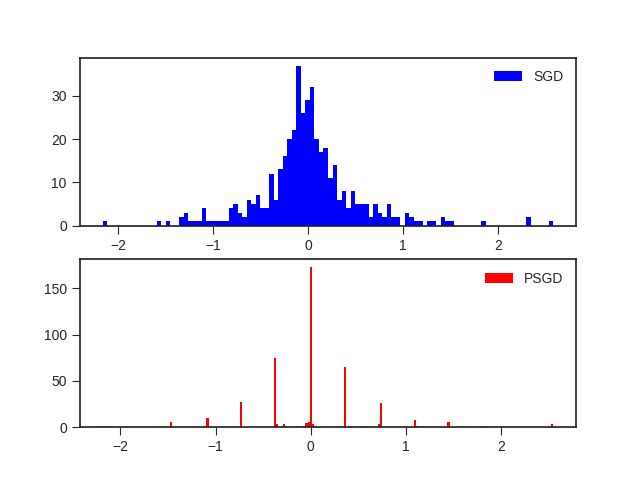This repository is the official implementation of Position-based Scaled Gradient for Model Quantization and Pruning.
The source code is for reproducing the results of Figure 1 of the original paper and Table 1A of Appendix A.
The repository provides the codes for training & visualization and pre-trained models.
To install requirements using environment.yml refer to the documentation.
torch=1.4.0
tensorboard=2.1.1
Manually installing the above packages will also work. Some visualization packages (matplotlib and seaborn) are also needed for running visualize.py.
train.py is the code for training with PSGD after the first learning decay. To train the model(s) in the paper, run this command:
python train.py --arch <choices=ResNet32, vgg16_bn> --seed <random seed> --cu_num <GPU_ID>
--lr <learning rate> --epoch <terminating epoch> --decay_epoch <lr decay epoch> --adam <whether to use adam optimizer>
--w_bit <target weight bit-width> --lambda_s <lambda_s> --first_last_quant <whether to quantize fl> --a_bit <target activation bit (no effect in training)>
--load_pretrained <path to pretrained model>
#The results from the original paper can be reproducd by running :
python train.py --arch ResNet32 --load_pretrained models/ResNet82.pth --lr 0.01 --epoch 150 --decay_epoch 123 --adam 0 \
--w_bit 4 --lambda_s 150 --first_last_quant 1 --seed 1 --cu_num 0
The code for training vanilla pre-trained model is not included, but the checkpoint file is provided. One can train from scratch or continue training from a vanilla model, which is the method used in the original paper.
Please refer to the original paper and Appendix C for further training details.
Modification to DATASET_PATH in the source file may be needed.
To evaluate the model with specified bit-widths, run:
python eval.py --arch <choices=ResNet32, vgg16_bn> --model_path <path to model> --cu_num <GPU_ID>
--w_bit <target weight bit-width> --a_bit <target activation bit> --lambda_s <lambda_s for recording> --first_last_quant <whether to quantize fl>
--act_quant <whether to quantize activation> --act_clipping <whether to clip activation range> --clipping_range <value of n for clipping>
#The results from the original paper can be reproduced by running :
python eval.py --arch ResNet32 --model_path models/W4_ResNet.pth --w_bit 4 --a_bit 4 --lambda_s 150 --first_last_quant 1 \
--act_quant 0 --act_clipping 0 --cu_num 0
When activation is also quantized, the best clipping range can be found on the training set. For more details, please refer to Section 5 of Data-Free Quantization Through Weight Equalization and Bias Correction.
We provide two pre-trained models:
- models/W4_ResNet.pth : PSGD-trained targeting 4-bit (150 epochs)
- models/ResNet150.pth : SGD-trained (150 epochs)
- models/ResNet82.pth : SGD-trained (82 epochs) used for training PSGD
For more implementation details, please refer to Appendix A and Appendix C.
For further details on other bit-widths refer to Table 1A of Appendix A :
| Model | Full precision | W4A32 |
|---|---|---|
| ResNet-32 | 70.08% | 69.57% |
For visualizing the weight distributions, run visualize.py.
Change the paths in the source code for visualizing other models than the provided ones. Defualt: 'visualizations/'
This will save figures of all convolutional layers of PSGD- and SGD- trained models of the provided pre-trained models in the 'visualizations' folder
Please refer to the following citation if this work is useful for your research.
@misc{kim2020positionbased,
title={Position-based Scaled Gradient for Model Quantization and Pruning},
author={Jangho Kim and KiYoon Yoo and Nojun Kwak},
year={2020},
eprint={2005.11035},
archivePrefix={arXiv},
primaryClass={cs.CV}
}
